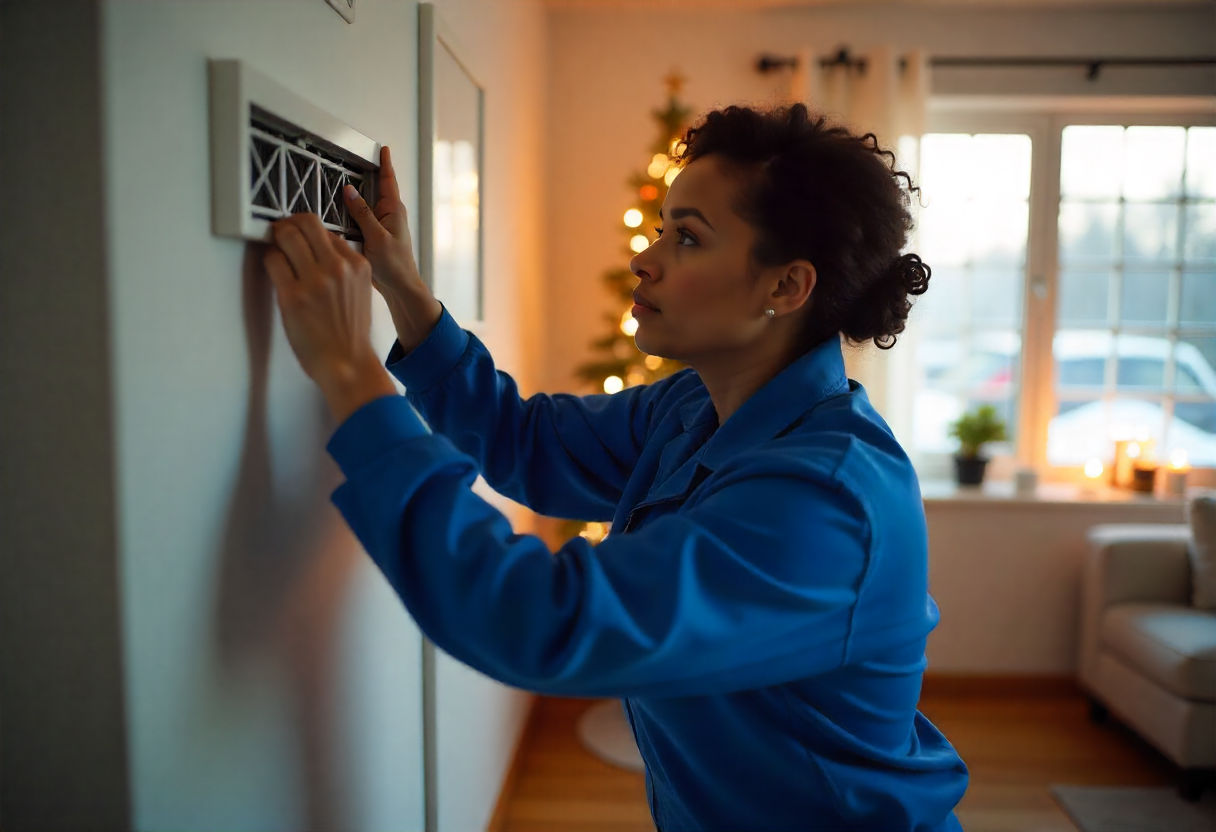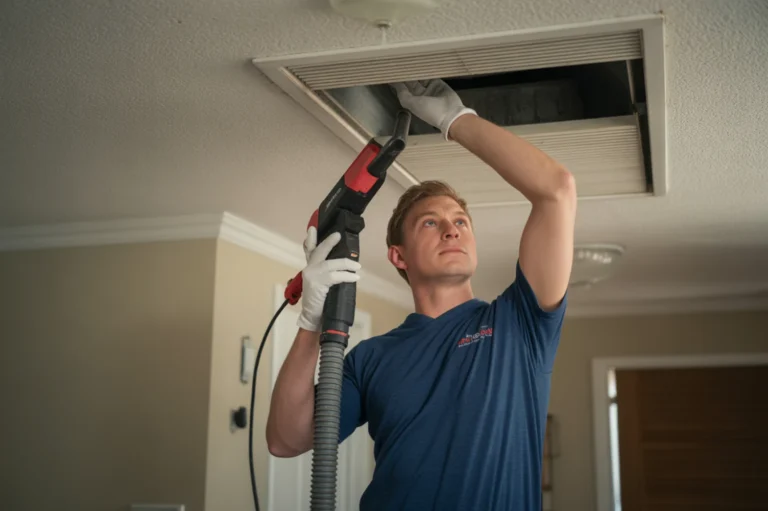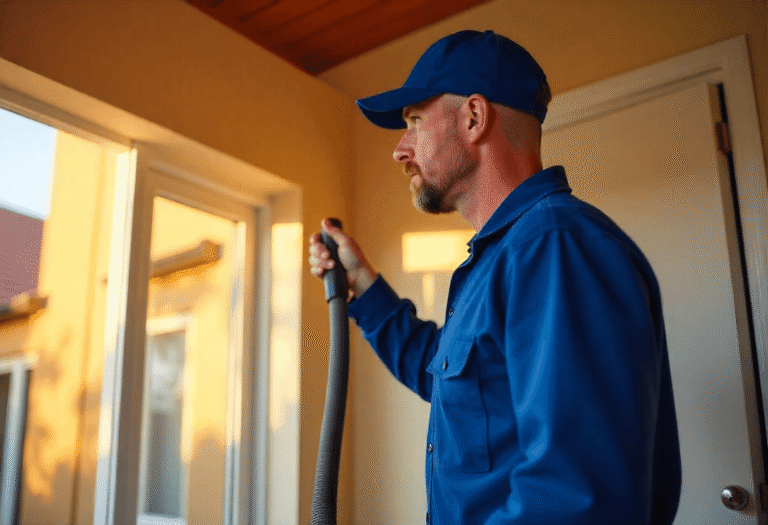Homes are supposed to be safe havens for people with allergies. But a lot of people tell me they suffer almost year-round allergic reactions at home.
This, they say, happens even when the windows are closed and their home feels clean.
So what’s going on here?
Well, one sneaky culprit could be the air ducts.
That’s because when your air ducts are full of dust, pet hair, mold, or other irritants, they also spread these allergens and make you feel miserable.
Now, a lot of homeowners suggest their allergic reactions significantly after air duct cleaning.
And that brings us to one question: Does air duct cleaning help with allergies or is it a waste of money?
The truth is, it depends.
In some cases, cleaning the ducts can make a huge difference, while in others, it might not help at all.
In this article, I will help you figure out when duct cleaning is worth it for your home and health and when it isn’t effective.
Let’s get started.
Key takeaways
- Indoor allergies are common even in clean-looking homes.
- Dust, pet hair, mold, and other allergens can build up inside air ducts.
- Duct cleaning can help, but only if those allergens are in the ducts.
- It won’t help if the allergy sources are carpets, furniture, or bedding.
- Poorly done duct cleaning can make allergies worse.
- If it’s been 5+ years since your last cleaning, it might be time.
- Pet owners, allergy sufferers, and recently renovated homes benefit most.
- HEPA filters, UV lights, and dehumidifiers are also great for air quality.
- Spring or Fall is the best time to clean ducts.
- Always hire a certified, professional company.
How do dirty air ducts trigger allergies?

Before we dive into duct cleaning, let’s quickly talk about what allergies are and how dirty air ducts trigger them.
Allergies happen when your body overreacts to something harmless.
Here, instead of ignoring things like dust or pollen, your immune system treats them like a threat. And this is when sneezing, watery eyes, runny nose, and itchy throat kick in.
Now, a lot of these allergy triggers are inside your home’s air ducts. They include:
- Dust mites (tiny bugs that live in dust)
- Pet dander (tiny flakes of skin from dogs and cats)
- Mold spores
- Pollen that sneaks in through windows or doors
- Cockroach droppings (gross, but real)
Over time, these allergens build up and get stirred around as you use your HVAC system.
Worse, they can stay in the air you breathe all day long. And that’s exactly why some people feel sick indoors because of their air ducts.
Schedule Your Free Estimate Today
Contact us to improve your indoor air
quality with our expert cleaning services in NJ.
Does air duct cleaning help with allergies?
Let’s cut to the chase.
Yes, air duct cleaning can help with allergies. But only if they are part of the problem.
You see, if your ductwork is full of dust, pet hair, mold, or other allergens, then cleaning it out can definitely make a huge difference.
However, if your ducts are already clean and your allergies are coming from somewhere else, like carpets or bedding, then cleaning them probably won’t do much.
I’ve detailed when duct cleaning really helps and when it doesn’t.
When does air duct cleaning help with allergies?

Air duct cleaning can help reduce allergic reactions in a lot of situations. More so if it’s been a while since you last got the ducts cleaned.
Here are the most common situations where cleaning your air ducts can offer real allergy relief:
1. If your ducts are dusty
Dust isn’t just on your shelves, it also collects inside air ducts. And it gets blown back into your rooms every time the HVAC system runs.
For people with allergies, this means sneezing, itchy eyes, and poor air quality.
Thankfully, duct cleaning removes all that trapped dust and fine particles from the system. So when the air flows again, it’s cleaner, fresher, and has fewer allergens.
2. If your ducts are full of pet dander
Got pets at home?
If yes, your ducts might be full of their hair and dander.
Here’s why:
In homes with dogs or cats, fur and dander easily settle inside air ducts. So, every time you turn on heating or cooling, allergen-filled air flows inside, triggering allergic reactions and leaving people sneezing.
Now, a good duct cleaning removes that trapped pet mess and helps the air feel fresher. It’s a relief for allergy sufferers, especially in the mornings or while sleeping when allergic reactions peak.
3. If you had renovation or construction work done recently
Construction creates a ton of dust which includes drywall particles, sawdust, insulation bits. And a lot of that ends up in your HVAC ducts.
This leftover debris can circulate throughout your home for weeks, worsening allergies.
So, if your home was recently remodeled, cleaning your air ducts is essential to stop the debris from circulating through your rooms.
4. If there’s mold or moisture in the system
Mold can grow inside air ducts when there’s a lot of humidity or moisture. This is a serious trigger for many allergy sufferers.
So, if you smell something musty when the HVAC is on, or you’ve had past water damage, I suggest you get a duct inspection done. And if mold is found, you should get the ducts cleaned right away.
5. If it’s been over five years since the last duct clean-up
Dust settles in your ductwork over the years. And experts suggest cleaning them at-least every 5 to 7 years, especially if someone in the home has asthma or allergies.
After all, regular cleaning removes all built-up dust, pollen, and debris, making it easier to breathe.
In short: Here’s when air duct cleaning helps with allergies
| Situation | Why It Helps |
| Ducts are dusty | Removes particles that get blown back into rooms |
| Ducts have pet dander or hair | Clears out allergens from pets that trigger sneezing and irritation |
| Recent renovation work | Removes drywall dust, sawdust, and debris that circulate through the system |
| Mold or moisture in ducts | Eliminates mold spores and damp smells that worsen allergies |
| Haven’t cleaned ducts over five years | Gets rid of years’ worth of allergen buildup |
When air duct cleaning doesn’t help with allergies?

Air duct cleaning isn’t a miracle cure. and in some cases, it might not help at all.
Here’s when duct cleaning might not help at all:
1. If the problem is somewhere else
Allergens don’t just live in air ducts. That’s because allergy triggers can also come from things like:
- Dirty carpets or rugs
- Bedding that’s not washed frequently
- Curtains or fabric furniture
- Poor outdoor air quality sneaking in
In these cases, duct cleaning alone won’t solve the problem.
2. If your ducts are already clean
Some homes just don’t have a serious buildup in their HVAC system. This is especially true for newer homes or ones with regular filter changes and maintenance.
Here, cleaning the ducts might not make any noticeable difference.
3. If the job Is done poorly
Sometimes, unqualified duct cleaners can actually make things worse by stirring up dust and not fully removing it.
This can leave allergens floating in the air and make your symptoms even more intense.
In short: Here’s when air duct cleaning doesn’t help with allergies
| Scenario | Why It Doesn’t Help |
| Allergens are in carpets/furniture | Ducts aren’t the source and surface cleaning is needed |
| Ducts are already clean | No buildup to remove = no real difference |
| Poor-quality cleaning job | Dust gets stirred up but not removed, making air quality worse |
Can air duct cleaning worsen allergy symptoms?

Yes, air duct cleaning can actually make allergies worse in some cases.
Surprising as it might sound, it happens when the job is done poorly or by someone who’s not properly trained.
Here’s how:
1. Dust gets stirred up but not removed
If the cleaner uses weak equipment or skips steps, they might just loosen all the dust and allergens inside the ducts without fully vacuuming them out.
The dust then blows straight into your living space, making symptoms even worse and exposing you to other dangers of indoor air pollution.
2. Chemical cleaners can trigger reactions
Some companies use harsh chemicals or strong disinfectants to sanitize ducts.
But if those fumes linger or aren’t fully rinsed out, they can irritate your lungs, especially if you have asthma or chemical sensitivities.
3. Mold spores are not handled properly
If mold is present and not removed the right way (with containment and filtration), spores can actually get released into the air during cleaning. And this is the exact opposite of what you want.
In short: Here’s when duct cleaning can make the situation worse
| Mistake | Effect |
| Dust not fully removed | Circulates allergens into the air |
| Use of harsh chemicals | Irritates lungs, especially in people with asthma or chemical sensitivity |
| Mold not handled properly | Releases spores into the air, making allergy reactions worse |
Bonus: Here are some other ways to reduce allergy reactions at home
Duct cleaning can help with allergies. But it’s just one piece of the puzzle.
Here are some other simple things you can do to breathe easier at home:
1. Use HEPA filters
Install HEPA filters in your HVAC system and vacuum cleaners. They catch tiny particles like dust, pollen, and dander that regular filters can miss.
2. Install a UV light in your ductwork
UV lights can kill mold spores and bacteria as air flows through the system. And this is especially helpful in humid climates.
3. Run a dehumidifier
Mold and dust mites thrive in moist air and trigger allergic reactions. So, use a dehumidifier to keep your indoor humidity around 30–50 percent as it makes it harder for them to survive.
4. Vacuum and dust regularly
Use a vacuum with a HEPA filter, and clean surfaces at least once a week. Also, don’t forget to get under the furniture and behind vents while vacuuming.
5. Replace HVAC filters
Check your air filters monthly and replace them every 1-3 months, especially if you have pets or allergies.
6. Use air purifiers
Place air purifiers in bedrooms, living rooms, or anywhere you spend the most time.
Schedule Your Free Estimate Today
Contact us to improve your indoor air
quality with our expert cleaning services in NJ.
To sum up
By now, you know when does air duct cleaning help with allergies and when it doesn’t.
You see, if your air ducts are full of dust, pet dander, or mold, cleaning them out can lead to noticeable allergy relief.
But if the real problem is coming from carpets, furniture, or the great outdoors, then duct cleaning might not do much on its own.
That’s why I suggest you do the following:
- Look for the signs
- Start with an inspection
- Use duct cleaning as part of a bigger indoor air quality improvement plan
- Don’t skip air vent cleaning when cleaning the ducts
Got more questions or need to schedule air duct cleaning in your home or business?
You can get in touch with us!
At Clean Air Technologies, we are seasoned HVAC maintenance experts with nearly three decades of expertise. And we’ve got all your air duct cleaning requirements covered on a budget.
FAQs about air duct cleaning and allergies
Does duct cleaning cure allergies?
No, it doesn’t cure allergies.
But it can reduce the triggers that make them worse, especially if your ducts are full of dust, mold, or pet dander.
How often should I get my air ducts cleaned?
Most homes should have ducts cleaned every 2-3 years. And if it’s been over five years, you should schedule a cleaning right away.
Also, if you have pets, allergies, or a recent renovation, you might need it more often.
Can duct cleaning help with pet allergies?
Yes!
Pet hair and dander can collect inside ducts. So, cleaning them out helps reduce what’s blowing into your rooms.
What if my allergies got worse after duct cleaning?
It likely means the job was done poorly and dust might have been stirred up but not removed. This is why it’s so important to hire certified and experienced pros.
Is duct cleaning safe for people with asthma or severe allergies?
Yes, but only if it’s done correctly.
In fact, many asthma and allergy specialists recommend it along with other air quality improvements.
What’s the best time of year to do it?
Spring and fall are ideal. That’s because you’re switching between heating and cooling, and it’s a good time to clean out whatever has built up in between seasons.




